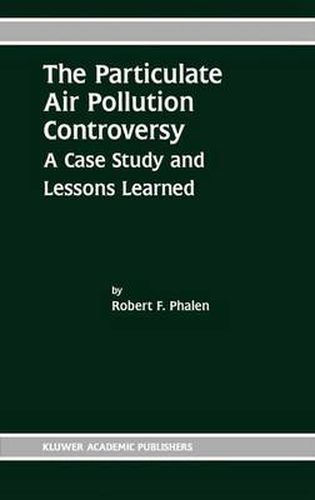Readings Newsletter
Become a Readings Member to make your shopping experience even easier.
Sign in or sign up for free!
You’re not far away from qualifying for FREE standard shipping within Australia
You’ve qualified for FREE standard shipping within Australia
The cart is loading…






This title is printed to order. This book may have been self-published. If so, we cannot guarantee the quality of the content. In the main most books will have gone through the editing process however some may not. We therefore suggest that you be aware of this before ordering this book. If in doubt check either the author or publisher’s details as we are unable to accept any returns unless they are faulty. Please contact us if you have any questions.
Do levels of particulate air pollutants claim thousands of lives yearly, or is the actual risk negligible? Scientists, regulators, legislators, producers, and portions of the lay public are all attempting to understand and respond to recent scientific findings that have significant consequences regarding public health, the economy and how hundreds of research programs are funded and guided. This concise book presents the relevant scientific data, historical developments, unsolved problems, and new research opportunities related to particulate air pollution and human health. Included are chapters on the nature of particulate air pollution, fates and toxicity of inhaled particles, evidence of harmful effects of air pollution, events that led to the current controversy, interpretation of modern epidemiology studies, needed research, challenges to commonly accepted ideas about pollutants and health, and recommendations for scientists, regulators, legislators, the public and industry. Modern technologies and rigorous efforts to control air emissions have produced significant improvements in air quality. Yet, modern city dwellers still inhale numerous tiny, invisible particles in each breath. Epidemiologists have repeatedly found associations between small day-to-day increases in particulate pollutants and adverse health effects. But are the associations strong enough to establish a cause and effect relationship? In addition, are stringent new controls on the sources of particulate pollutants warranted? The processes that produce particulate air pollutants also sustain public health. Tighter air regulations impact these processes and others that are difficult to change quickly. A co-ordinated worldwide effort to provide the research required to answer the critical questions has been launched. It is important that this research effort be given time to unfold.
$9.00 standard shipping within Australia
FREE standard shipping within Australia for orders over $100.00
Express & International shipping calculated at checkout
Stock availability can be subject to change without notice. We recommend calling the shop or contacting our online team to check availability of low stock items. Please see our Shopping Online page for more details.
This title is printed to order. This book may have been self-published. If so, we cannot guarantee the quality of the content. In the main most books will have gone through the editing process however some may not. We therefore suggest that you be aware of this before ordering this book. If in doubt check either the author or publisher’s details as we are unable to accept any returns unless they are faulty. Please contact us if you have any questions.
Do levels of particulate air pollutants claim thousands of lives yearly, or is the actual risk negligible? Scientists, regulators, legislators, producers, and portions of the lay public are all attempting to understand and respond to recent scientific findings that have significant consequences regarding public health, the economy and how hundreds of research programs are funded and guided. This concise book presents the relevant scientific data, historical developments, unsolved problems, and new research opportunities related to particulate air pollution and human health. Included are chapters on the nature of particulate air pollution, fates and toxicity of inhaled particles, evidence of harmful effects of air pollution, events that led to the current controversy, interpretation of modern epidemiology studies, needed research, challenges to commonly accepted ideas about pollutants and health, and recommendations for scientists, regulators, legislators, the public and industry. Modern technologies and rigorous efforts to control air emissions have produced significant improvements in air quality. Yet, modern city dwellers still inhale numerous tiny, invisible particles in each breath. Epidemiologists have repeatedly found associations between small day-to-day increases in particulate pollutants and adverse health effects. But are the associations strong enough to establish a cause and effect relationship? In addition, are stringent new controls on the sources of particulate pollutants warranted? The processes that produce particulate air pollutants also sustain public health. Tighter air regulations impact these processes and others that are difficult to change quickly. A co-ordinated worldwide effort to provide the research required to answer the critical questions has been launched. It is important that this research effort be given time to unfold.